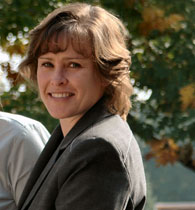Let the sunshine in
Mac clinic probes benefits of vitamin D
The homey, turn-of-the-century house with the wraparound porch at 7 Maple Avenue is unlike any other in Ste. Anne-de-Bellevue or Canada, in fact. Nestled inside are overstuffed chairs, warm hardwood floors, a cozy fireplace and a Hologic Discovery bone densitometer. This is the Mary Emily Clinical Nutrition Research Unit, one of the best-kept secrets of McGill University's Dietetics and Human Nutrition department.

Hope Weiler: Doing it for the kids
Helen Rimmer
Adjacent to Macdonald campus and its Faculty of Agricultural and Environmental Sciences, the former home of Walter and May Stewart was renovated and opened in 1998 for clinical research. The unit was a generous donation in 1995 from G. Stewart Brown in memory of his wife.
Since spring 2007, 40 breast-fed babies have been streaming through the house for a three-year study to discover the optimal level of vitamin D. According to Dr. Hope Weiler, Director of the Mary Emily, the Canadian Paediatrics Society reported that rickets—a childhood disease usually associated with developing countries—had recently reappeared in Canada.
"This showed the current recommendations for vitamin D are insufficient," she says. At present, Health Canada states adequate amounts for people under 50 years is 200 IU daily, then doubles every 20 years, to a safe maximum of 2,000 IU.
Infants are considered deficient with less than 27 nanomoles/litre in their blood. Rickets can appear as convulsions, respiratory distress, limb deformity and delayed development. Adult insufficiency is associated with autoimmune diseases, osteoporosis and cancer. Vitamin D is critical for individuals with darker complexions because the melanin that pigments the skin and acts as natural sunscreen also slows the skin's vitamin D-making ability in the presence of ultraviolet light.
"Mothers with darker pigmented skin may not drink enough milk or be exposed to enough sunlight to produce vitamin D in their bodies," notes Dr. Weiler. "If they are deficient, they cann't pass enough of the vitamin through breast milk to their babies." That's why rickets can appear in children from three months to three years of age, she says. The Sunshine Vitamin study is not looking at the minimal needed, she explains, but the ideal dose from infancy for lifelong health.
"Each visit is 90 minutes," says Catherine Vanstone, Clinical Research Coordinator and manager of the clinic. "We take the baby's weight, length and head measurements each visit and the mother's weight and height." There are also urine samples and a small blood sample from the baby's heel, as well as a breast milk sample from the mother. Mothers are asked to log their food consumption for three days prior to the visit. Their babies are provided with vitamin D drops to be given every day and six clinical visits are scheduled during their first year.
Dr. Weiler says they are still recruiting mothers and babies and wants to find a total of 160 participants. "Our mission is to promote health early in life," notes Dr. Weiler. "It's asking how much is the best for growth and how can we optimize it. We want to set up people for good, lifelong health."

